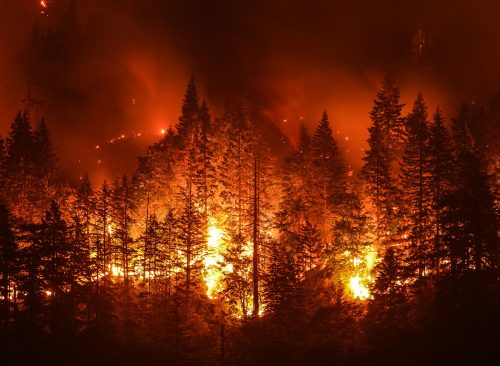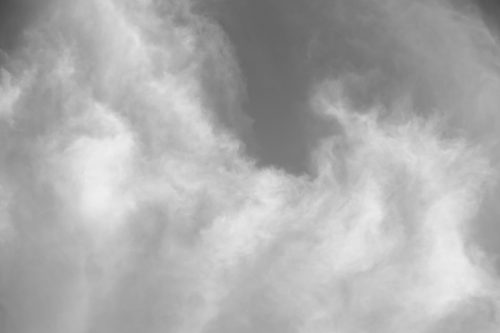Wildfire Smoke Has Blanketed the U.S.—Here's When the Air Will Finally Clear
Hazardous conditions impacting several areas may last longer than we hoped.

If you step outside right now, there's a chance that you may see smoky skies. Wildfires in Canada have fanned out fumes across the U.S., with smoke spreading over most of the eastern side of the country. This has prompted concern for millions of people from South Carolina to New Hampshire who are now under unhealthy air alerts, and health officials are warning them to avoid spending too much time outside. But how long will you be at risk from this wildfire smoke? Read on to find out when the air is expected to finally clear.
READ THIS NEXT: New "Highly Contagious" Skin Infection Is Spreading, CDC Warns—How to Stay Safe.
Hundreds of wildfires are burning in Canada right now.

The dark smoky air reaching across much of the U.S. right now is coming from our northern neighbor. There are 426 active wildfires in Canada as of June 6, according to the Canadian Interagency Forest Fire Centre (CIFFC). Of these, 240 of the fires are currently "out of control," the CIFFC warns.
This makes for one of the worst starts to Canada's wildfire season ever recorded, NBC News reported. According to the news outlet, federal officials have reported that over 6.7 million acres of land have already been burned from fires this year.
"Over the last 20 years, we have never seen such a large area burned so early in the season," Yan Boulanger, a researcher with Natural Resources Canada, told Reuters. "Partially because of climate change, we're seeing trends toward increasing burned area throughout Canada."
They're spreading smoke to many parts of the U.S.

These wildfires are not only a concern for Canada, however. Smoke started blanketing several states in the Eastern part of the U.S. on June 6—mostly because of recent fires that have broken out in the Canadian province of Quebec, the New York Times reported. As a result, air quality and pollution tracking company IQAir lists New York's air quality as "unhealthy" right now, and yesterday briefly even ranked it as the worst out of any major city in the world.
But how exactly are Canada's wildfires making the air quality so bad down here? According to the New York Times, a storm system off of the coast of Nova Scotia first pushed the smoke from around 150 active forest fires into the U.S. Then, as John Cristantello, a lead meteorologist for the New York City office of the National Weather Service, explained to the newspaper, a low-pressure system in New England helped send the smoke further down towards New York.
New York is hardly the only place feeling the effects of this right now, though. According to air quality monitoring company AirNow, there is currently "unhealthy" air quality in states such as Wisconsin, Indiana, Pennsylvania, New York, Virginia, Maryland, New Jersey, Connecticut, and Ohio. The smoke is even reaching parts of North Carolina, South Carolina, Tennessee, and Kentucky—causing air quality to become "unhealthy for sensitive groups," according to AirNow.
RELATED: For more up-to-date information, sign up for our daily newsletter.
Hazardous conditions are likely to last through the rest of the week.

As smoke continues to drift down from Canada, how long are those of us in the U.S. likely to be affected? Well, that's a complicated question—and it may also depend on where exactly you live. In New York City, which has been one of the hardest hit areas, unhealthy air quality is likely to last through the week. "It's going to be here for a while," Bryan Ramsey, a National Weather Service (NWS) meteorologist in New York, told the New York Times.
Overall, the smoke is likely to cycle throughout the Northeast and Mid-Atlantic into June 9 because of current currents, The Washington Post reported. According to the newspaper, it will pass through different areas in waves, causing improved air quality in-between throughout this time. But the smoke should be significantly weakened by this weekend due to a "greater westerly component to the winds," The Washington Post explained.
There are certain things you should do to keep yourself safe.

Bad air quality is not something to brush off, either. According to the World Health Organization (WHO), the effects of air pollution are linked to 6.7 million premature deaths every year. Exposure to pollution can result in inflammation and weaken your immune system, as small particles from smoke can penetrate your lungs and enter the bloodstream. "These are the particles that are small enough to breathe in and can cause cardiovascular issues," Brett Palm, a scientist at the National Center for Atmospheric Research in Boulder, Colorado, told NBC News.
So during situations like this, it is safest for you to stay indoors. If you do need to go outside, you should limit the amount of time and wear a high quality mask, according to the New York Times. But just being outside with bad air quality is enough to put you at risk—even if you're wearing a mask. "If you can see or smell smoke, know that you're being exposed," William Barrett, the national senior director of clean air advocacy with the American Lung Association, told CNN.





















